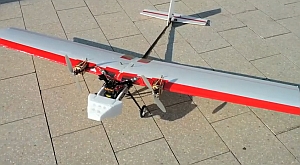Aeronautical and computer engineers at Massachusetts Institute of Technology built and tested an autonomously driven fixed-wing model aircraft guided by algorithms that let it navigate a complex indoor flight space. The team from MIT’s Robust Robotics Group describe their invention in a paper presented in May at the IEEE International Conference on Robotics and Automation.
Previous autonomous craft developed for indoor flight have been helicopter-style hover craft, to take advantage of their slower speed and maneuverability. The team led by Nick Roy, professor of aeronautics and astronautics and head of the Robust Robotics Group, used a fixed-wing solution, not only because of the more challenging guidance and control problems, but also because of its ability to stay in the air for longer periods of time. “The helicopter is working very hard just to keep itself in the air,” says Roy, “and we wanted to be able to fly longer distances for longer periods of time.”
In the conference paper, the authors including graduate students Adam Bry and Abraham Bachrach, describe their algorithm that determines the craft’s state — location, physical orientation, velocity, and acceleration — at any point in time. Since the conference, the authors built the algorithm into a fixed-wing model aircraft (pictured at top) and tested the craft inside a parking garage on the MIT campus.
The model craft, which the team built from scratch, has narrow wings but a long wingspan that allows it to fly at slow speeds, yet still support the electronics to run the algorithm. Those electronics include an Atom processor found in off-the-shelf netbook computers. The guidance software also has a digital map of the test area, which its builders agree is an advantageous condition for its early tests.
Nonetheless, the guidance system still needs to continuously calculate 15 different factors, from data generated by an on-board laser range-finder, accelerometers, and gyroscopes. These instruments feed the algorithm that computes the craft’s orientation, velocity, and acceleration. The algorithm makes use of two types of state-estimation models, one that emphasizes accuracy and one that puts a premium on speed. The guidance system uses the speed model as the default, calling on the accuracy model when needed.
To plot the plane’s trajectory, the team adapted a motion-planning model written by colleagues in MIT’s Aerospace Robotics and Embedded Systems Laboratory. Those motion-planning calculations, however, assume the data on the craft’s state is reliable, an assumption that the developers could not make. As a result, the researchers added a computed probability of reliability to feed into the colleagues’ motion-planning model.
The next step for the Robust Robotics Group team is to develop algorithms that can build a map of the flight environment in real time, which will require adding visual information to the range-finder’s measurements and the inertial data. “There are definitely significant challenges to be solved,” says Bry.
The following video shows the model aircraft in its flight tests
- Algorithms Devised to Aid Inspections of Mines on Ship Hulls
- Small-Scale Surveillance/Emergency Robot Developed
- Navigation Module for Inside Buildings in Development
- Robot Jellyfish Runs on Hydrogen, Oxygen in Water
- Algorithms Plot Optimal Autonomous Underwater Vehicle Routes
* * *


 RSS - Posts
RSS - Posts
You must be logged in to post a comment.